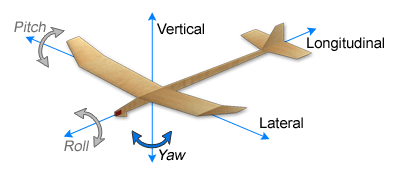Yaw (Directional) Stability
A disturbance about the yaw axis could occur (for example) by a gust of wind coming from the side of the aircraft. This could result in a force on the fuselage or vertical stabilizer causing the aircraft to rotate about the vertical (yaw) axis. Once the gust of wind stops, the vertical stabilizer will "weather vane," bringing the aircraft back to its stable position. This weather vane effect is essentially a side lift, so the ability of the vertical stabilizer to return the aircraft to a stable orientation will largely depend on the surface area of the vertical stabilizer.

The Yaw Axis

Directional Stability
The vertical stabilizer (or fin) must have enough surface area to cause the glider to rotate back to a stable position. But if the vertical stabilizer is too large, it will be unnecessarily heavy and potentially cause an unwanted shift in the overall center of gravity of the glider. A good rule of thumb is to design a fin with a surface area that has about 1/3 to 1/2 of the surface area of the horizontal stabilizer. Use the Yaw Stability Ratio to establish the right size.
A good rule of thumb is to design a fin with a surface area that has about 1/3 to 1/2 of the surface area of the horizontal stabilizer.